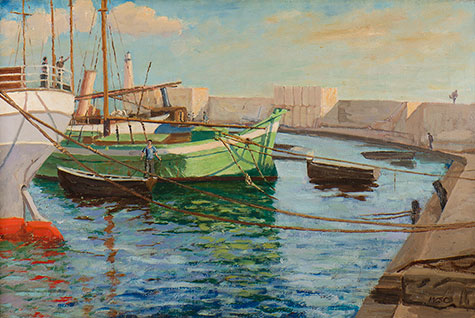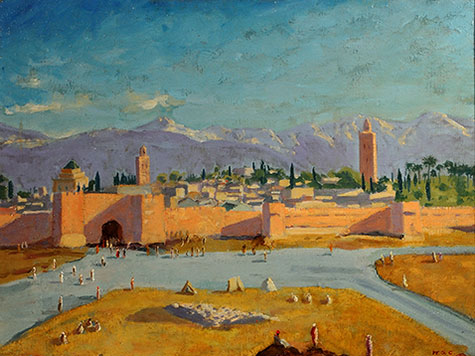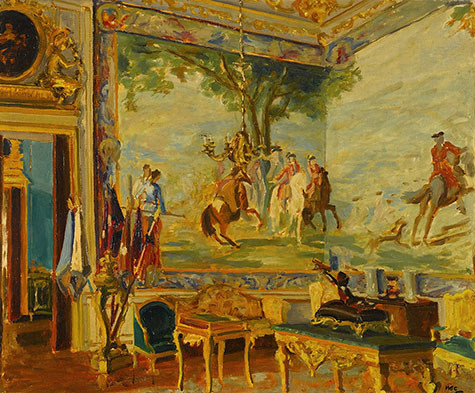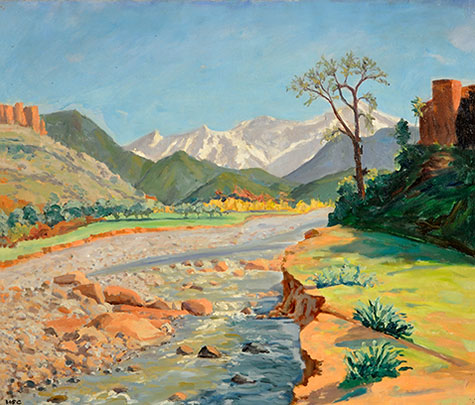The shore is rendered in soft warm blues and thick buttery yellows. Swimmers wade into the water as a heavy black cannon trains a gleaming barrel towards the darkening horizon.
“Beach at Walmer” (c. 1938) is a picture of stubborn vigilance, all the more resonant for the circumstances of its creation. Painted on the English Channel shortly before the outbreak of World War II, it is the work of Winston Churchill, the future prime minister and a chief architect of Allied victory, but then a lonely voice in British Parliament warning against the Nazi storm.
This fall, the National Churchill Museum at Westminster College in Fulton, Mo., and the Mildred Lane Kemper Art Museum at Washington University in St. Louis will feature “Beach at Walmer” and 46 other works in the exhibit “The Paintings of Sir Winston Churchill.” Presented in association with “Churchill 2015,” a worldwide commemoration of the 50th anniversary of Churchill’s death, the exhibition is among the most significant displays of Churchill’s work ever in North America.
Featured are canvases representing five decades of Churchill’s paintings, drawn from public and private collections in the United Kingdom, Canada and the United States. Also included are Churchill’s traveling easel, one sculpture by Churchill and a portrait of Churchill by Sir John Lavery. Major lenders include Chartwell, Churchill’s historic family estate in Kent and part of The United Kingdom National Trust for Places of Historic Interest or Natural Beauty, as well as The Royal Academy of Arts, London, and the Beaverbrook Art Gallery in Canada.
“This exhibition collects most of the very best of Churchill’s painting,” said Timothy Riley, painting curator for the National Churchill Museum and co-author, with Churchill’s granddaughter Edwina Sandys, of “Winston Churchill: A Passion for Painting,” forthcoming from The National Churchill Museum and Donning Company Publishers.
“Some of these works have seldom, if ever, been seen outside of the United Kingdom. It represents an incredible opportunity, for museum-goers and students of history alike, to explore who, as an artist, Churchill truly was,” he said.

‘Audacity is the only ticket’
Today, Churchill is remembered as the “British Bulldog” who lifted spirits amidst the London Blitz, rousing Great Britain to what he memorably called its “finest hour.” Many consider his “Iron Curtain” speech, which diagnosed the dangers of postwar Soviet expansionism — and which was delivered at Westminster College — to mark the beginning of the Cold War.
Yet Churchill also was a dedicated amateur artist. He first took up brushes in 1915 at age 40, after being ousted as First Lord of the Admiralty during Britain’s disastrous Gallipoli campaign. “I had great anxiety and no means of relieving it,” he recalled in his 1921 essay “Painting as a Pastime” (later the basis of a book). But in the weeks that followed, he watched with interest as his sister-in-law painted in the garden. She urged him to give it a try.
For the rest of his life — at home, on holiday and even, occasionally, on the battlefield — Churchill’s oils were rarely far from hand. Painting was a joy and a consolation, a source of sustenance and an intellectual challenge. He became an avid museum-goer, befriended such contemporary painters as Lavery and Paul Maze, and copied works by Paul Cézanne and John Singer Sargent, among many others.
“There really is no time for the deliberate approach,” he observed. “Two years of drawing lessons, three years of copying woodcuts, five years of plaster casts … these are for the young.”
For the self-taught latecomer, “audacity” as he once famously said, was “the only ticket.”

‘Painting is like a battle’
Churchill often discussed his craft in military terms. “Painting is like a battle,” he mused, “and trying to paint a picture is, I suppose, like trying to fight a battle.” But the battle on canvas, at least, was seldom explicitly political. Of his nearly 575 completed paintings, 350 are landscapes or seascapes. Instead, Churchill grappled with the materials, techniques and traditions of painting itself. It was a battle to capture everything at once, the parts and whole, in all their simultaneous complexity.
Still, as “Beach at Walmer” demonstrates, Churchill’s painting was not immune to external circumstance. “Tower of Koutoubia Mosque” (1943), the only painting Churchill was able to complete during World War II, commemorates a trip to Marrakech, Morocco, which he visited with Franklin D. Roosevelt following their historic Casablanca Conference.
Churchill later gave the painting to Roosevelt as a symbol of their friendship, and Marrakech — with its historic architecture and views of the Atlas Mountains — would prove a favorite subject to which the painter frequently returned. In 1951, Churchill delivered a similar canvas to Harry S. Truman, calling it “about as presentable as anything I can produce.”
Such self-deprecation, especially in a world leader, is perhaps strategically charming, yet the remark does seem to capture the mix of pride and genuine humility with which Churchill viewed his art. Indeed, for a man of his gifts and responsibilities, the opportunity to indulge an honest enthusiasm must have felt a profound relief. As the “pastime painter” once remarked to Sir John Rothenstein, director of the Tate Gallery:
“If it weren’t for painting, I couldn’t live. I couldn’t bear the strain of things.”

Hours and sponsors
“The Paintings of Sir Winston Churchill” is a collaboration between the National Churchill Museum at Westminster College and the Kemper Art Museum, part of the Sam Fox School of Design & Visual Arts.
This exhibition is made possible by the generous leadership support of corporate sponsor Edward Jones, the J.M. Kaplan Fund and Mr. and Mrs. Richard J. Mahoney, with additional support from partner sponsors Mr. and Mrs. Stephen F. Brauer, the Allen P. and Josephine B. Green Foundation, and Mr. and Mrs. Earle H. Harbison Jr.; contributing sponsors Mr. and Mrs. John W. Bachmann, The St. Louis Trust Company, and Dr. and Mrs. Robert L. Virgil; and associate sponsors Suzanne and David Richardson and Mark S. and Risa Zwerling Wrighton. It is supported by an indemnity from the Federal Council on the Arts and the Humanities.
The exhibition opens with a public reception from 7-9 p.m. Friday, Nov. 13, and remains on view through Feb. 14, 2016. The museum is located on Washington University’s Danforth Campus, near the intersection of Skinker and Forsyth boulevards. Regular hours are 11 a.m.-5 p.m. daily except Tuesdays and 11 a.m.-8 p.m. the first Friday of the month. The museum is closed Tuesdays.
The museum is open to the public and admission is free.
For more information, call 314-935-4523; visit kemperartmuseum.wustl.edu; or follow the museum on Facebook, Twitter and Instagram.

